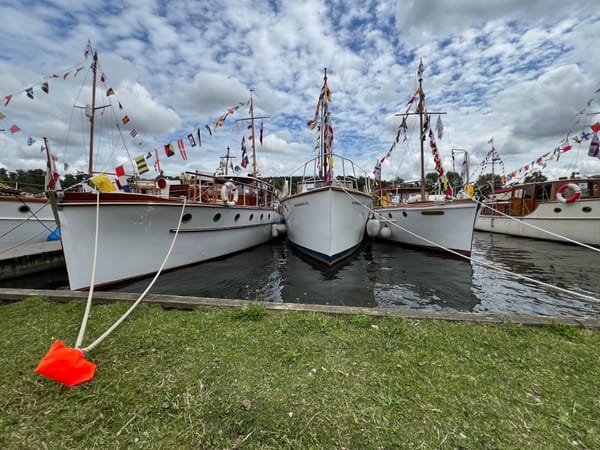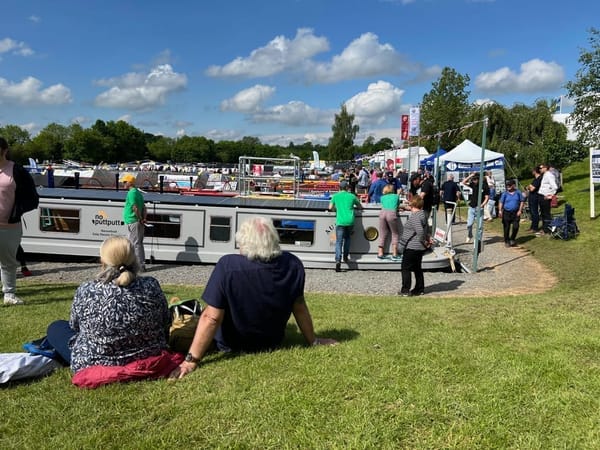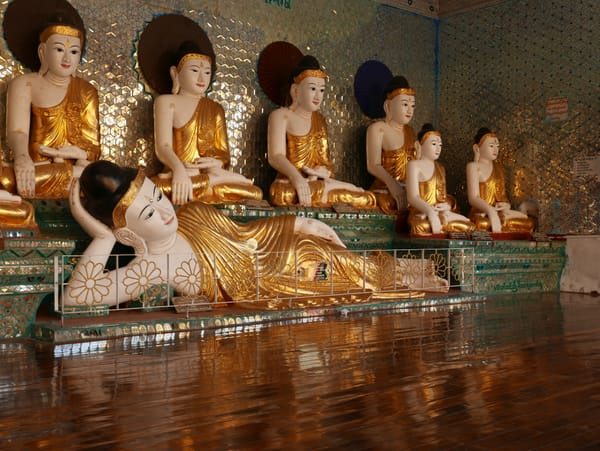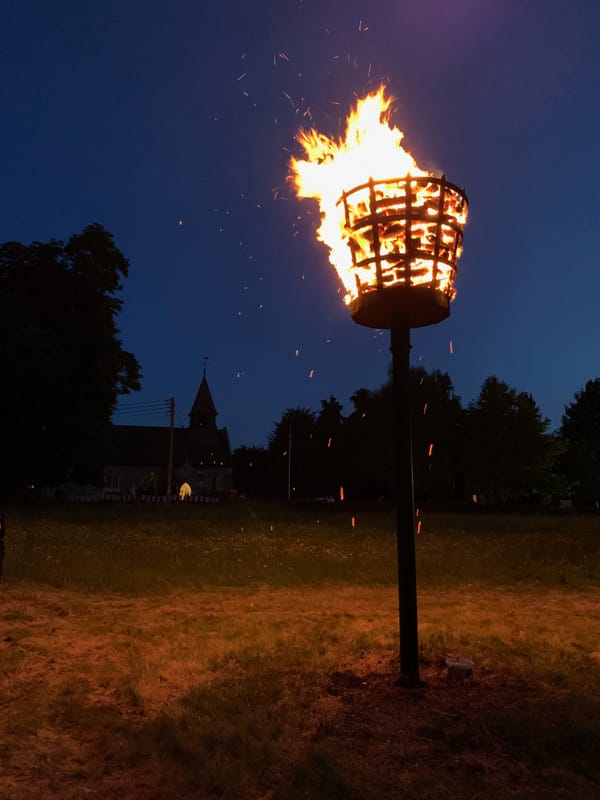Cambodia — Angkor National Museum, Siem Reap, Cambodia
A visit to the museum
September 2015
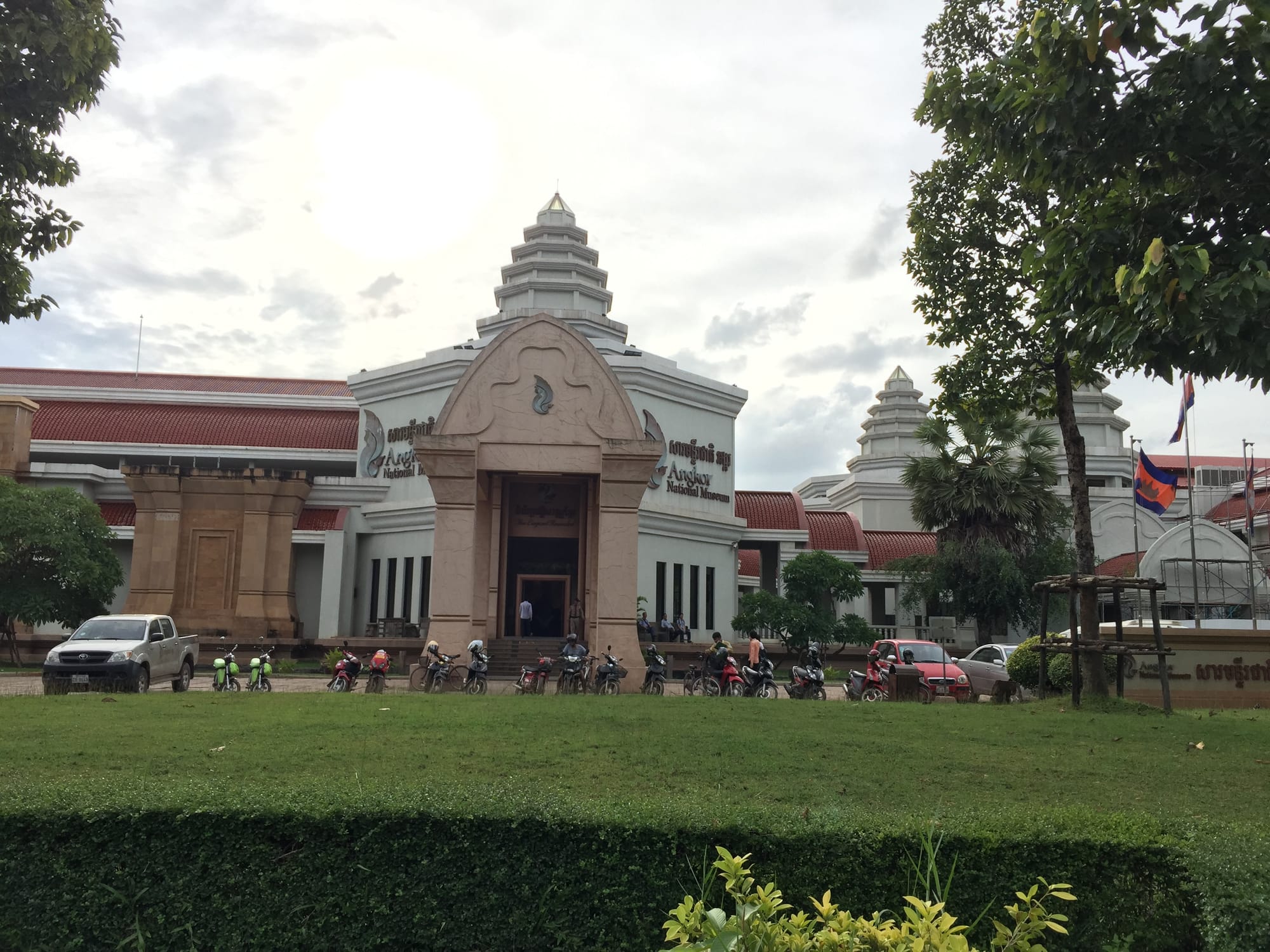
Angkor National Museum was worth visiting as I saw some of the carvings removed from the temples. And the cravings were spectacular. The museum was also very good at explaining the history of the temples and the kings who built them.
There was a charge to enter the museum, and bags had to be left at the doors. There was a no-camera policy, which annoyed me as I like to photograph exhibits and information boards so that I can look at things later. (When wandering around a museum, I never have enough time to read all the information available.)
I could understand the no-camera policy a few years ago when cameras needed a flash, but now with modern digital cameras, there is no need for a flash. Maybe there should be a ‘no flash’ policy?
My first stop was ‘The Room of a Thousand Buddhas’.
The Room of a Thousand Buddhas
The first room I entered was the Room of a Thousand Buddhas.
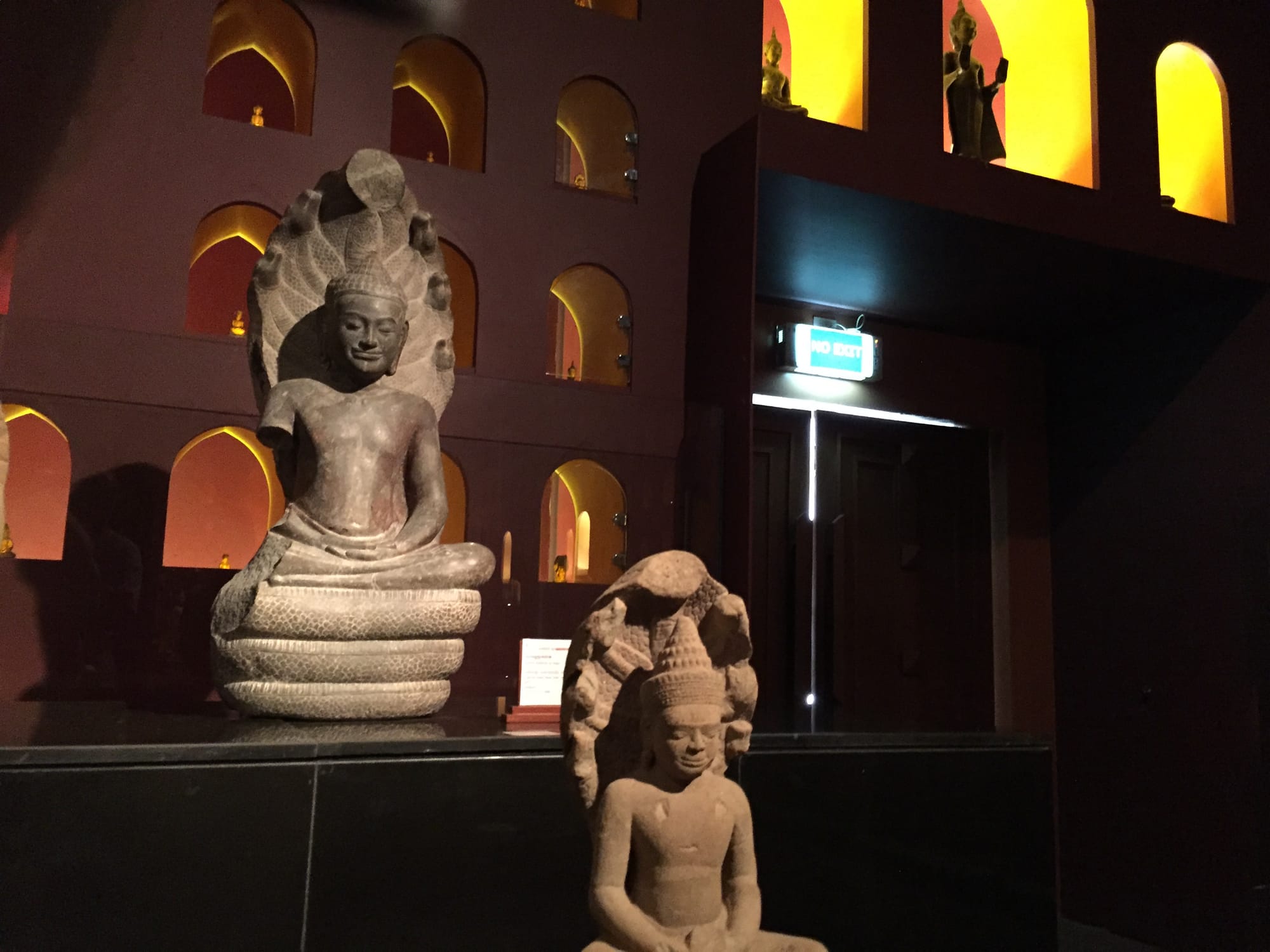
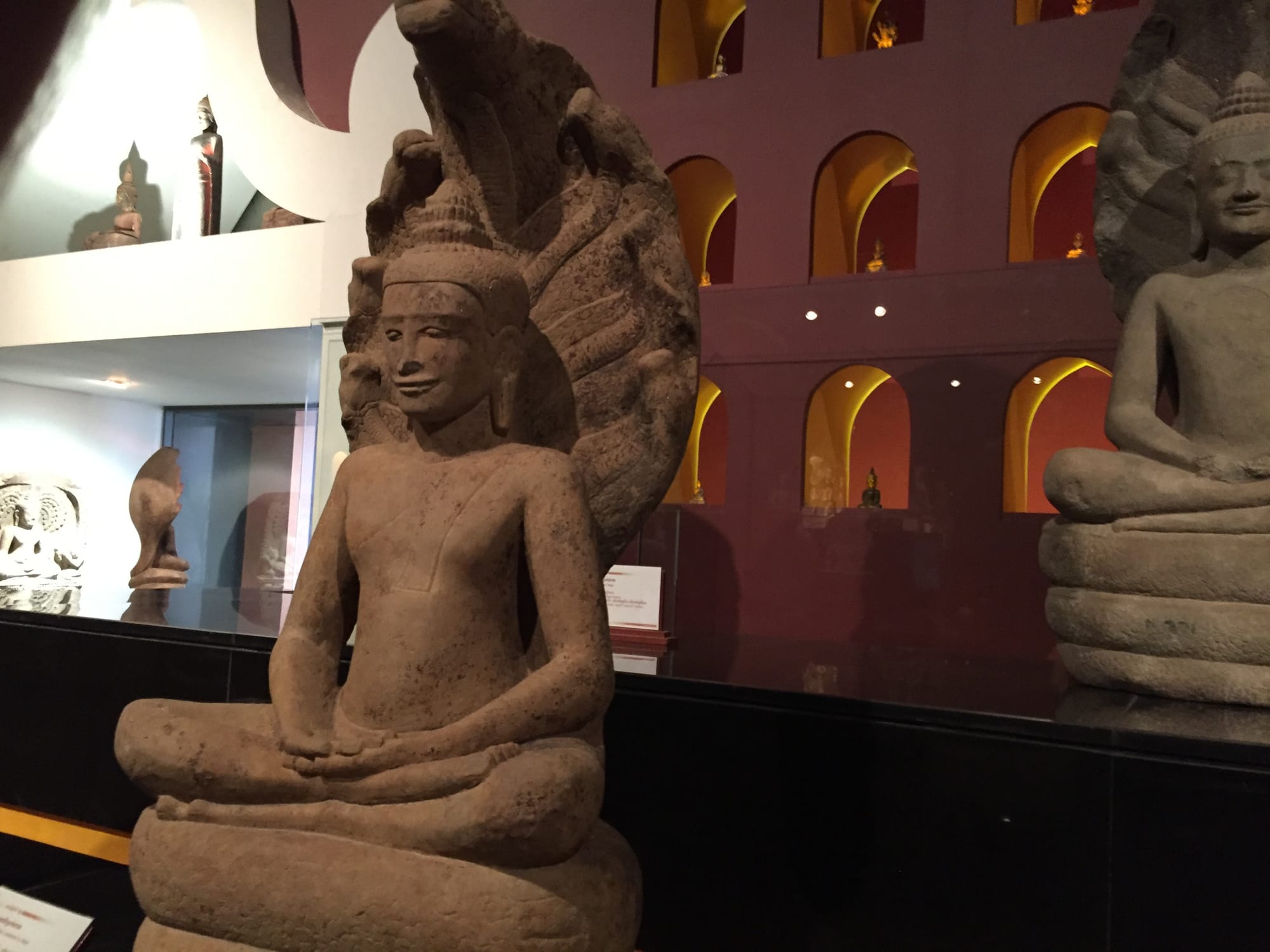
It was interesting how in the Room of a Thousand Buddhas, you saw an evolution in the hairstyle of the Buddhas. What started off looking like a bun of hair on top of the head became a pointed structure.
The room had an odd feel, with 1000 Buddhas looking at you.
The Khmer Civilisation
The next room, Khmer Civilisation, had an excellent history of the region and contained many statues.
The museum was almost a better place to admire the skills of the stonemasons than the temples, as there were very few other visitors, and you could get quite close to the work. The details on the carvings were stunning.
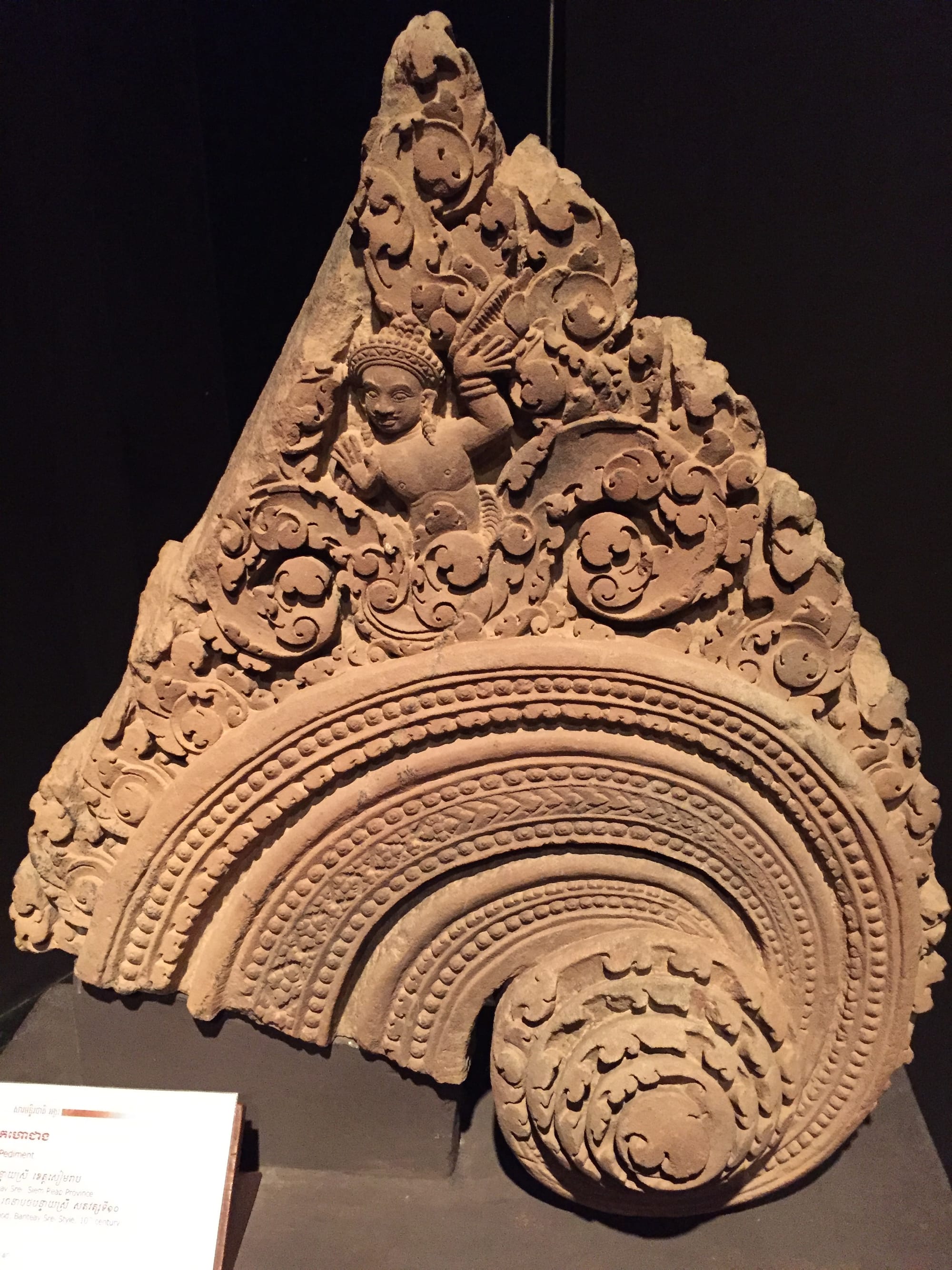
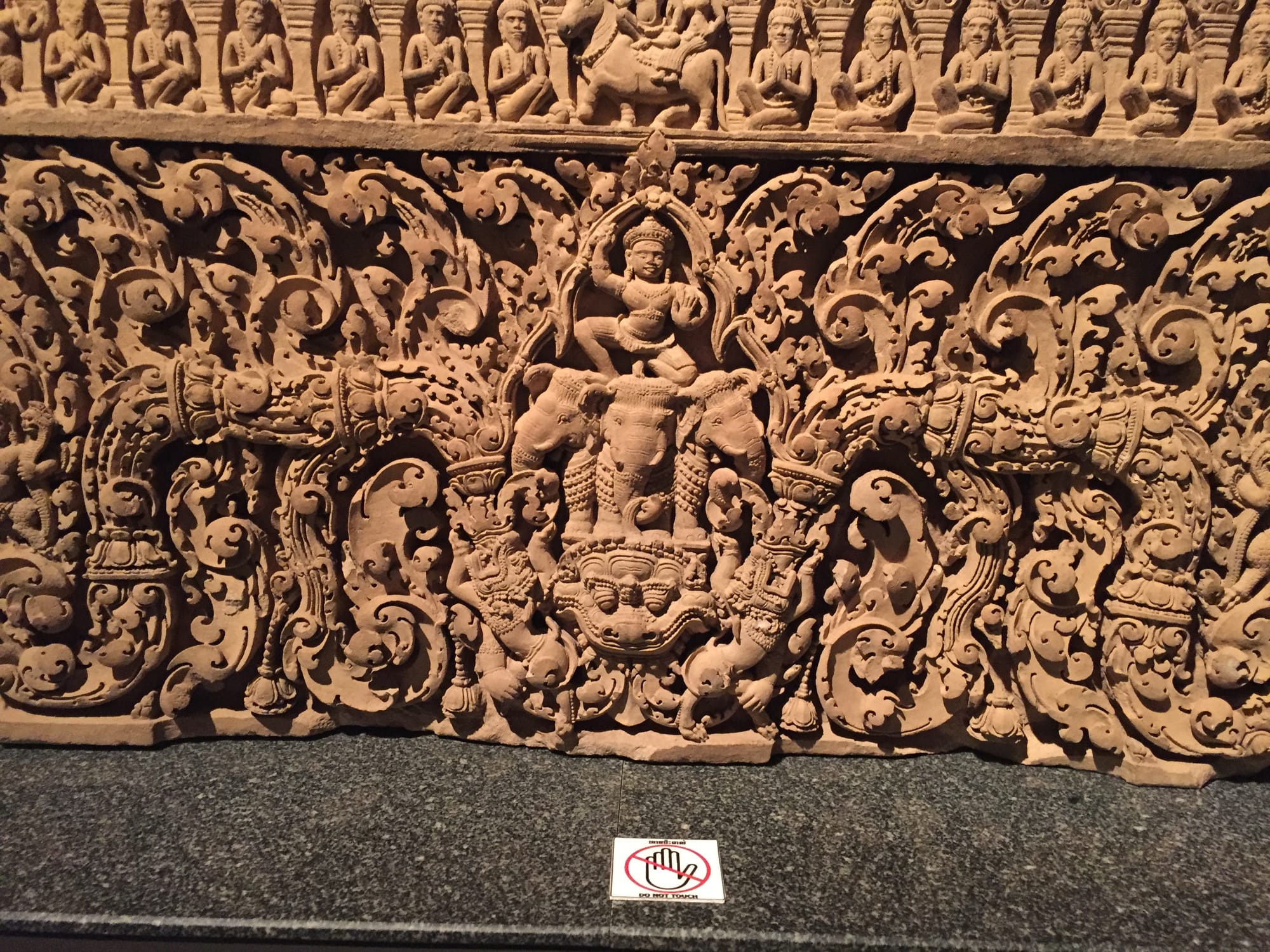
According to what I read in the museum, the Khmer civilisation is one of the oldest in Southeast Asia. India influenced the countries of Southeast Asia, and the Chinese referred to the countries as Fu-Nan (Funan) and Lin-Yi. The Chinese also described Nokor Phnom (Cambodia) and Champa, with the inhabitants of Nokor Phnom referred to as Khmers and Champa the Chams.
I found this introduction to Khmer Civilisation confusing as I couldn’t understand how Nokor Phnom and Champa related to the region or each other. From reading the material in the museum, the Nokor Phnom region seemed to be what is now part of modern Cambodia, and the Champa central and southern Vietnam. But I may be wrong.
But, what I did appreciate and understand, were the three defined histories of Cambodia:
- Pre-Angkorian — 1st-8th Centuries
- Angkorian — 9th-13th Centuries
- Post-Angkorian — 14th-20th Centuries
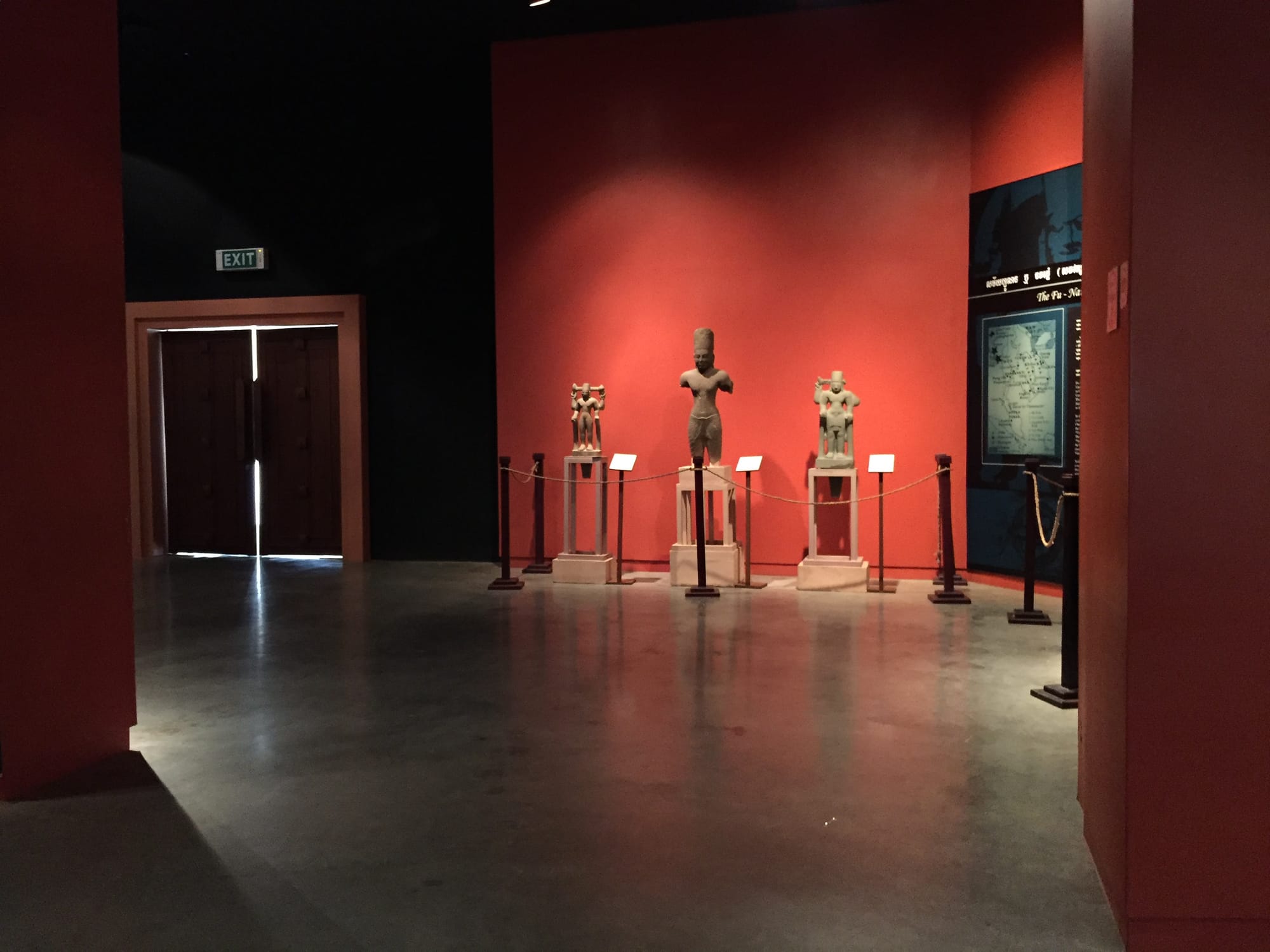
In the Pre-Angkorian Period (1st-8th centuries), Shiva (a god associated with reproduction and dissolution and which can form a triad with Brahma and Vishnu, referred to as the Trimurti) is represented by a Linga, a symbolic representation of the male reproductive organ. I had previously seen Linga at temples in Bali.
The Lingas are always with Yoni, which represents the female reproductive organ and is represented by a rectangle with a lip that rests on a support called a snanadroni.
In some Khmer Mythology, the universe’s birth resulted from the union of the forces of the sun and the earth, with the Linga, the sun, and Yoni, the earth. The idea is that the sun’s light, in contact with the earth, caused the birth of life, creation, and the development of human, animal, and plant life. Which, if you think about it, is what happened.
In Khmer art, the Linga can be made of bronze or stone in various shapes and sizes. The Linga can be cylindrical or a combination of three different forms, with the different shapes symbolising the three divinities of the Trimurti — the cubic base representing Brahma, the octagonal Vishnu and the hemisphere Shiva.
In the Angkorian period (9th-13th centuries), the Linga often included a human face on the hemisphere section. This type of Linga is called Mukhalinga.
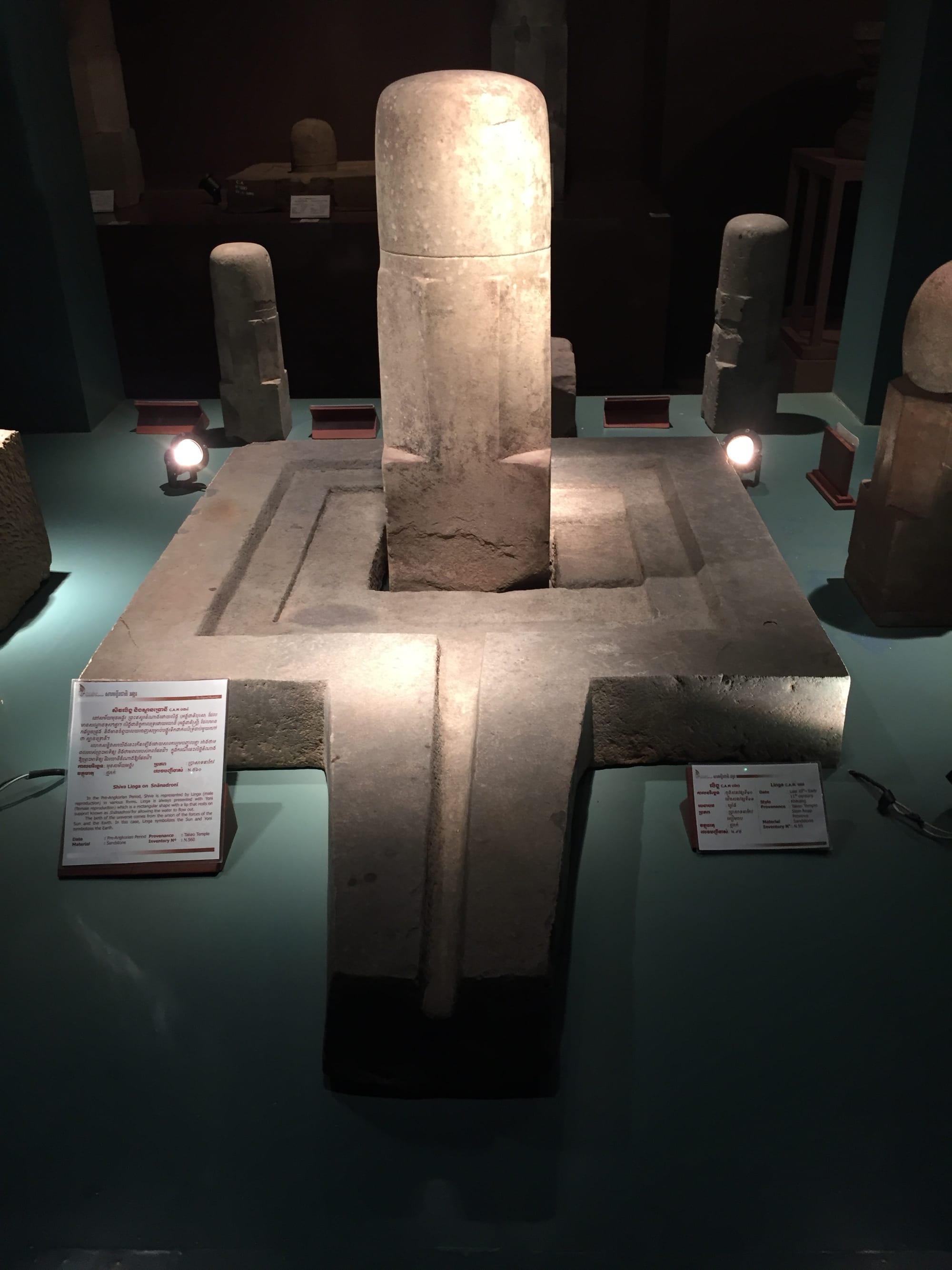
The museum also gave a summary of the kings of the Pre-Angkorian (1st-8th centuries) and Angkorian (9th-13th centuries) periods.
King Jayavarman II (802-850)
King Jayavarman II is viewed as the founder of the Angkorian monarchy and was the king who freed the country from the rule of Java in 802.
On his return from Java, he set up his first capital at Indrapura, probably now in Banteay Prei Nokor, Kampong Cham province.
Later, he moved his capital city to Hariharalaya, near Rolous, about 15 km from Angkor. He moved his capital again to Amarendrapura, then Mahendraparvata, and finally back to Hariharalaya.
During his reign, he had the temples of Damrei Krap, O Paong, Khting Slap, Rup Areak, Neak Ta, Trong Khla Khmum, and Krus Preah Aram Rong Chen built.
King Jayavarman III (850-877)
I found no information on this king at the Angkor National Museum. Even Wikipedia says very little is known about this king.
King Indravarman I (877-889)
King Indravarman I ruled from 877 to 889, his capital was at Hariharalaya, and he had the same purohita (a Brahman priest responsible for royal ceremonies) — Sukshmavindu — as King Jayavarman III.
King Indravarman I built the Preah Ko temple in 879, which he dedicated to his ancestors, and the Bakong temple in 881, which became his state temple.
The king also had the 3.8 km by 800 m Indratataka Reservoir constructed. The reservoir played an essential role in social and religious life.
King Yasovarman I (889-910)
King Yasovarman I was the son of King Indravarman I.
King Yasovarman I, like his father, started his reign at Hariharalaya but later moved to Yasodharapura (now called Angkor).
King Yasovarman I ordered the construction of the temples:
- Lolei — built in the middle of the Indratataka reservoir and dedicated to his parents and grandparents.
- Bakheng — dedicated to Shiva
- Phnom Krom — dedicated to the Trimurti gods (Brahma, the creator, Vishnu the preserver and Shiva, the destroyer)
- Phnom Bok — dedicated to the Trimurti gods (Brahma, the creator, Vishnu the preserver and Shiva, the destroyer)
- Preah Vihear — dedicated to Sikharesvara
The king also built the Yasodharatataka (now called East Baray) reservoir.
King Isanvarman (Ishanavarman) II (???-921)
King Isanvarman (Ishanavarman) II was mentioned at the Angkor National Museum, and the only reference I found was in the information section for King Jayavarman IV (921-941).
King Jayavarman IV (921-941)
King Jayavarman IV ruled from 921 to 941.
Jayavarman IV succeeded Isanvarman II (or that might be Ishanavarman), and his wife (Jayadevi) was the sister of King Yasovarman I.
King Jayavarman IV moved the capital from Yasodharapura (Angkor) to Chok Gargyar (Koh Ker), where he had an artificial lake (560 m by 1,200 m) created.
At Gargyar, King Jayavarman IV had the following temples constructed — Koh Ker group (Preah Vihear), Neang Khmao (Takeo), and Choeung An (Kampong Cham).
King Rajendravarman (944-968)
The information at the museum told me that Rajendravarman was the son of King Mahendravarman and Mahendradevi. But, I could see no other mention of King Mahendravarman and Mahendradevi.
King Rajendravarman reigned from 944 to 968 and moved the capital from Gargyar (Koh Ker) to Yasodharapura (Angkor).
Rajendravarman ordered the construction of the East Mebon temple at Angkor and dedicated it to his ancestor in 952.
Rajendravarman also had Pre Rup built as his state temple. Pre Rup was dedicated to Shiva.
Prasat Baksei Chamkrong (another temple at Angkor) was also completed during his reign, along with Bat Chum, Banteay Srei, and Baksei Chamkrong.
King Suryavarman I (1002-1050)
At the museum, it was unclear who reigned between 968 and 1050.
King Suryavarman I came to the throne through his maternal line.
King Suryavarman I had his capital at Angkor and seemed to have ordered the construction of many temples and buildings. These include in:
- Siem Reap Province — South Khleang, Phimeanakas (the Royal Palace) and Takeo
- Takéo Province — Phnom Chisor
- Preah Vihear Province— Preah Khan (Kampong Svay), Preah Vihear
- Battambang Province — Prasat Snoeung, Prasat Ek Phnom, Prasat Wat Baset
- Kampong Cham Province — Phnom Thom, Kuk Khvet, and Kuk Pring Chrum
Suryavarman I and his family believed they were divine (god-kings), also called the Devaraja cult, but he is also thought to have practised Buddhism.
King Jayavarman VII (1181-1218)
The museum made no mention, as far as I could see, as to who ruled after King Suryavarman I (1002-1050) until King Jayavarman VII in 1181. Who ruled for these 131 years? What went on?
I discovered in one part of the museum that King Jayavarman VII defeated the Chams in 1182, who had occupied Angkor since 1177. So, that covered part of the period; the Chams occupied the region, but what happened between 1050 and 1177? There was mention of a King Dharanindravarman II (father of King Jayavarman VII) who ruled from 1150 to 1160, but that still leaves a gap of 100 years.
King Jayavarman VII was the son of King Dharanindravarman II (1150–1160) and Queen Sri Jayarajacudamani. And he had two wives, Jayarajadevi and Indradevi. His second wife, Indradevi, was the sister of Jayarajadevi, and he married Indradevi when Jayarajadevi died.
During his reign, King Jayavarman VII ordered the construction of his capital, Angkor Thom, plus Bayon, Ta Prohm, Preah Khan, Banteay Kdei, Neak Pean, Ta Som, Ta Nei, Kool Ko and others, including 121 rest houses 15 km along important routes and 102 hospitals.
The Angkor Wat Display
The Angkor Wat Display at the Angkor National Museum, Siem Reap, Cambodia, was impressive.
As I walked in, I was the only person in there; I triggered a video, which was very good, but with inferior sound which echoed in the room, making it difficult to hear. The commentary was in English and used three misaligned projectors to project panoramas. There was a fantastic model of Angkor Wat in the centre of the room.
There were several videos to watch, and you could select the language.
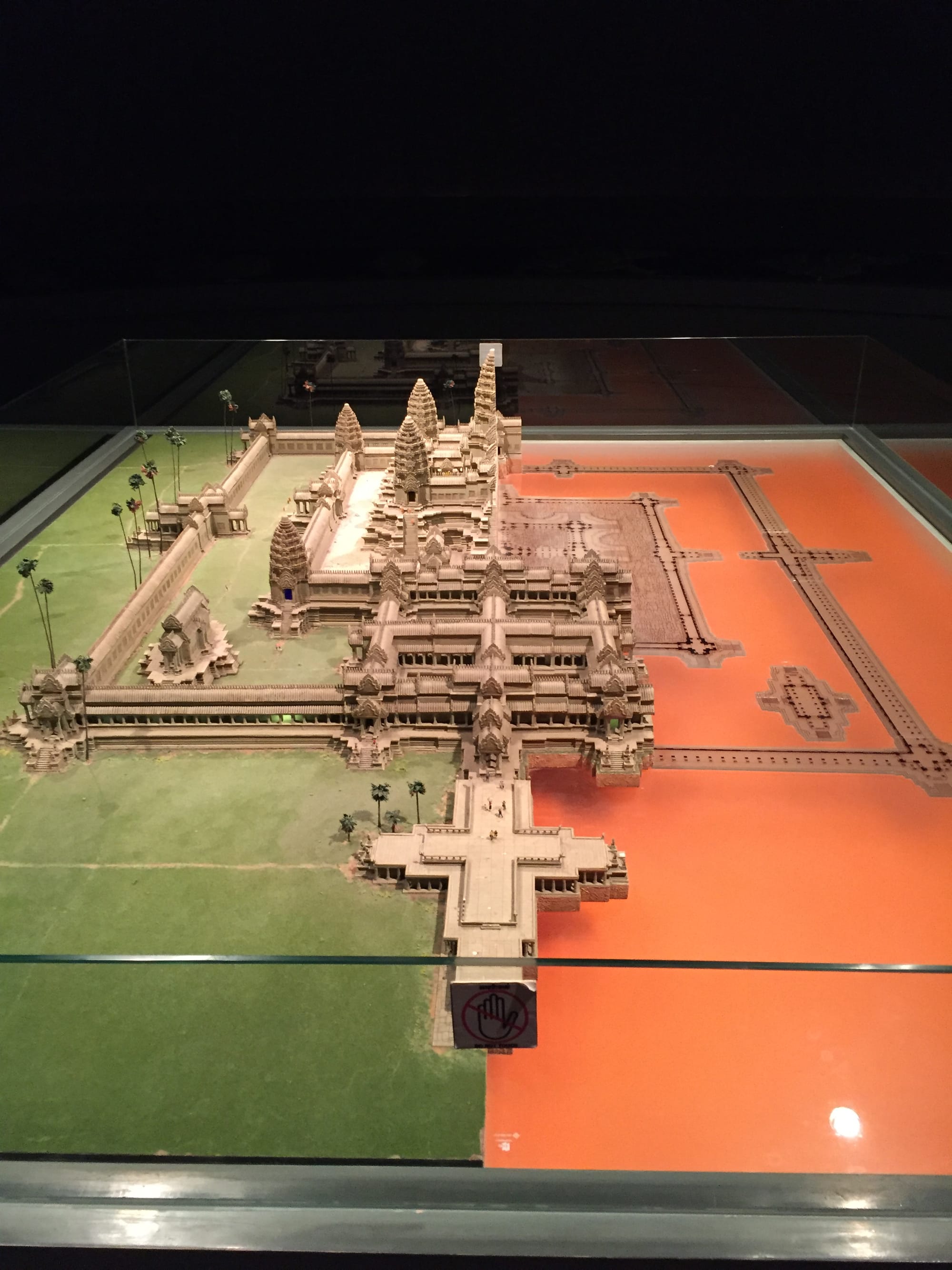
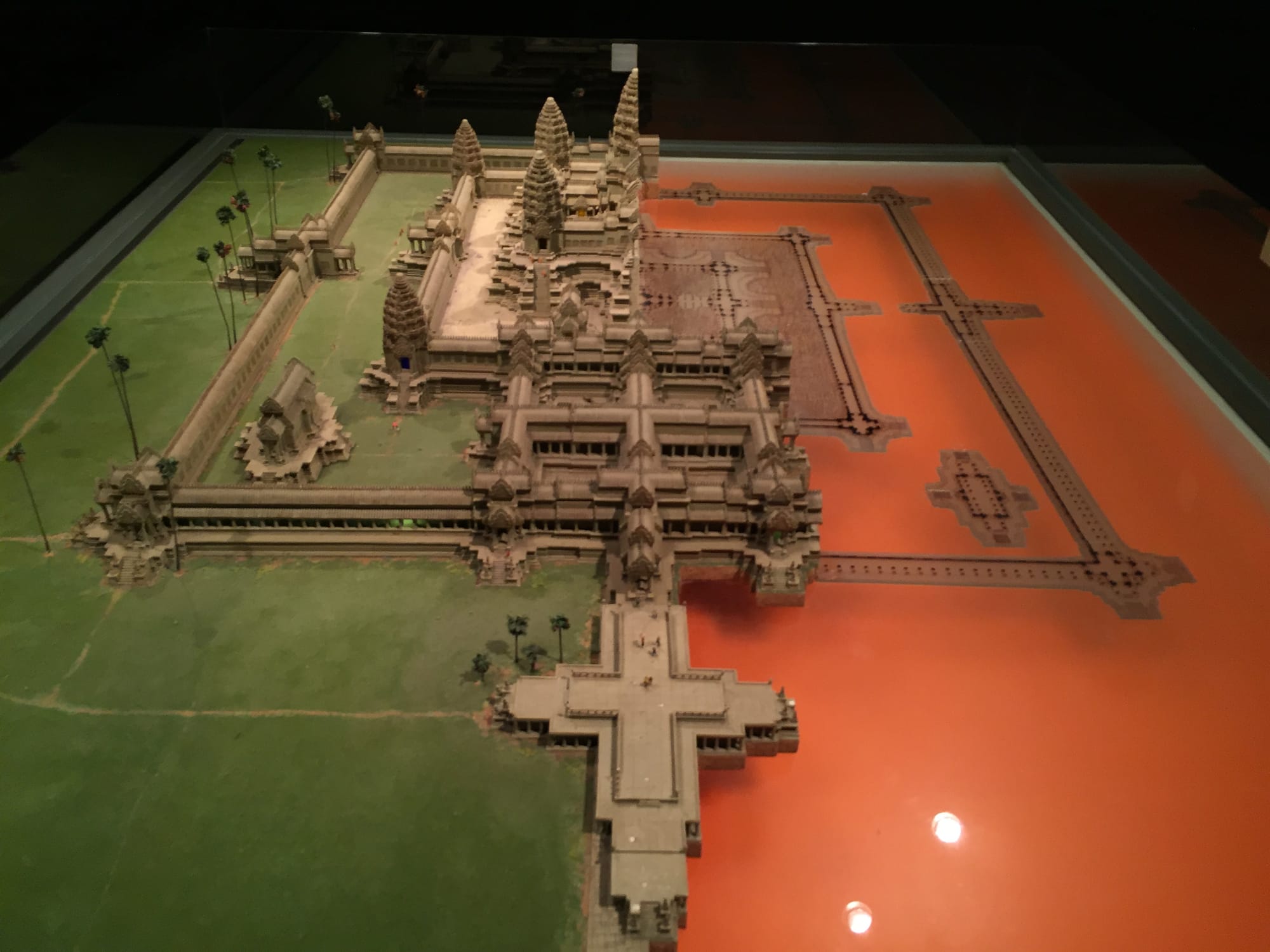
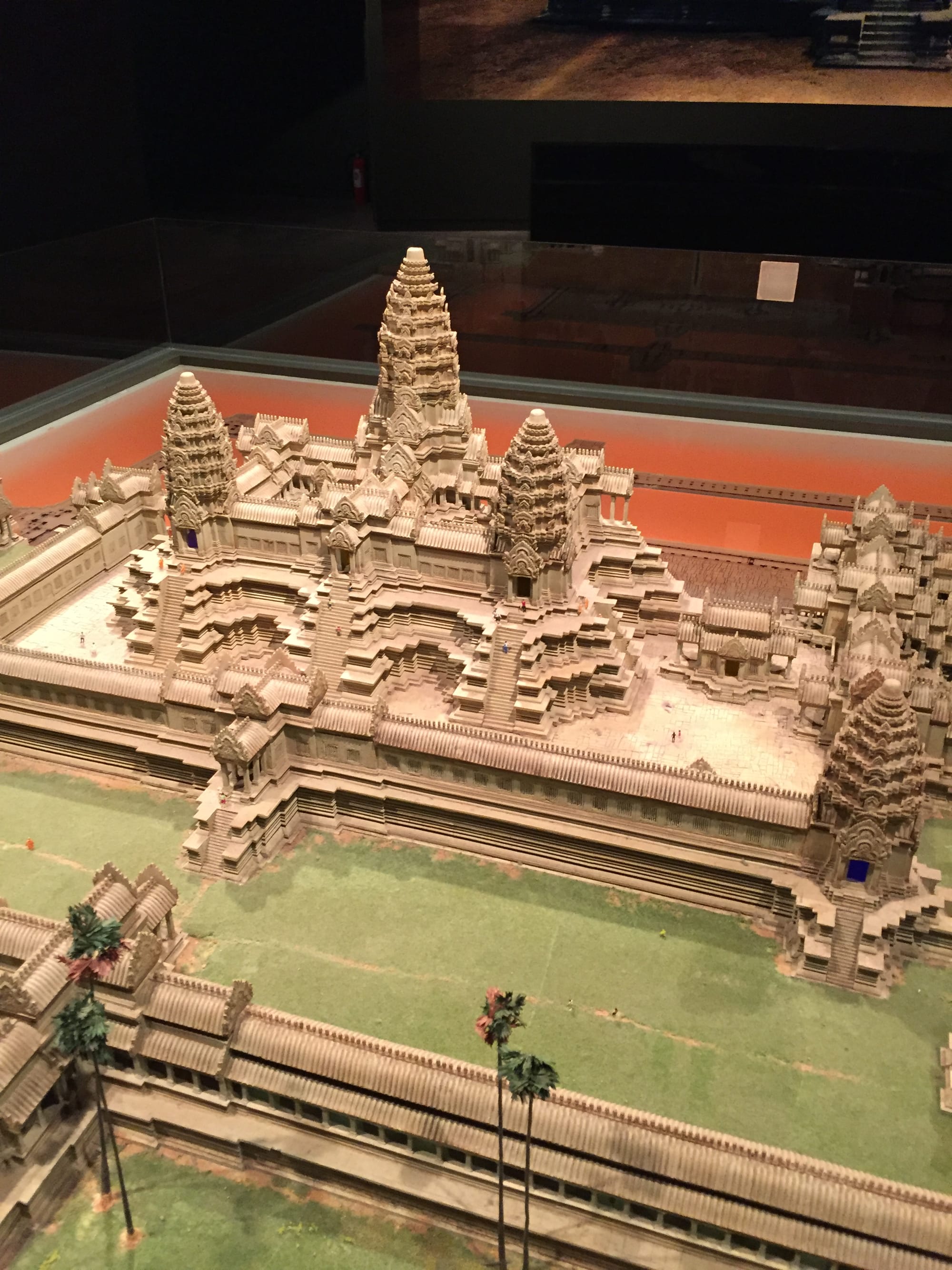
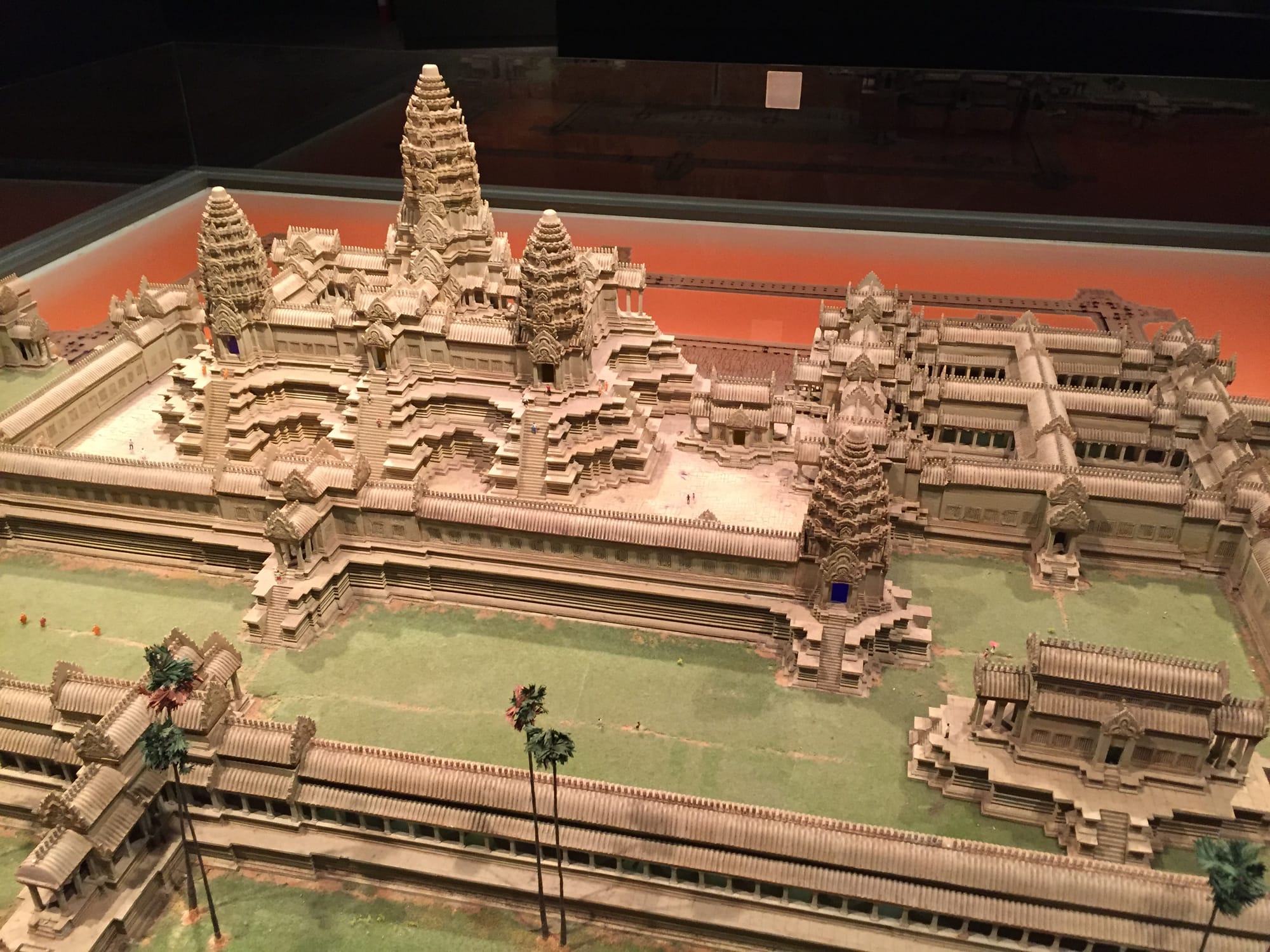
Angkor Thom
The final part of the museum I visited was the Angkor Thom display.
King Jayavarman VII (1181-1218) built Angkor Thom as his capital. And it was the last capital of the Khmer Empire in the Angkor period. A moat (100 m wide and 13.2 km long) surrounds the 9 km² Angkor Thom site.
The display also provided information on King Jayavarman VII (1181-1218).
King Jayavarman VII was 55 when he came to the throne, and as he ruled from 1181-1218, some 37 years, he must have been 92 when he died. He was a Mahayana Buddhist and built many Buddhist temples during his reign.
In 1182, at the age of 55, he defeated the Chams, who had occupied Angkor since 1177.
During his reign, he ordered the construction of many stone-paved roads across hundreds of kilometres across the kingdom. The roads were constructed to be above the flood level and had resting places every 15 km. Some of these roads can still be seen or are now the basis of some modern roads in Cambodia.
Jayavarman VII’s first wife was Jayarajadevi, originally a Hindu, who later converted to Buddhism at her sister’s suggestion. In part, her conversion was to bring the king success in his campaigns to free Angkor from the Chams.
Summary
The Angkor National Museum was worth visiting, and I wish I had visited the museum before going on my ‘temple tour’ as the museum helped put the history of the region into context and gave me a more in-depth understanding of the temples and their construction.
Foursquare: Angkor National Museum
